Managing a Successful Business Project: A Case Study of H&M Company
VerifiedAdded on 2024/05/17
|38
|5651
|326
Report
AI Summary
This report provides a comprehensive analysis of managing a successful business project at H&M, focusing on the implementation of digital technologies within the marketing and HR departments. The project management plan outlines the objectives, strategies, and scope, including a work breakdown structure and Gantt chart for effective execution. Small-scale research, utilizing both qualitative and quantitative analysis, assesses the impact of digital technology on H&M's business activities. The performance review incorporates research analysis and meaningful recommendations, reflecting on the value of the research undertaken. The project aims to enhance sales and improve overall business operations through strategic digital transformation, addressing the competitive challenges faced by H&M in the UK retail market. Desklib offers a range of similar solved assignments and past papers for students.

Managing a Successful
Business Project
Business Project
Paraphrase This Document
Need a fresh take? Get an instant paraphrase of this document with our AI Paraphraser
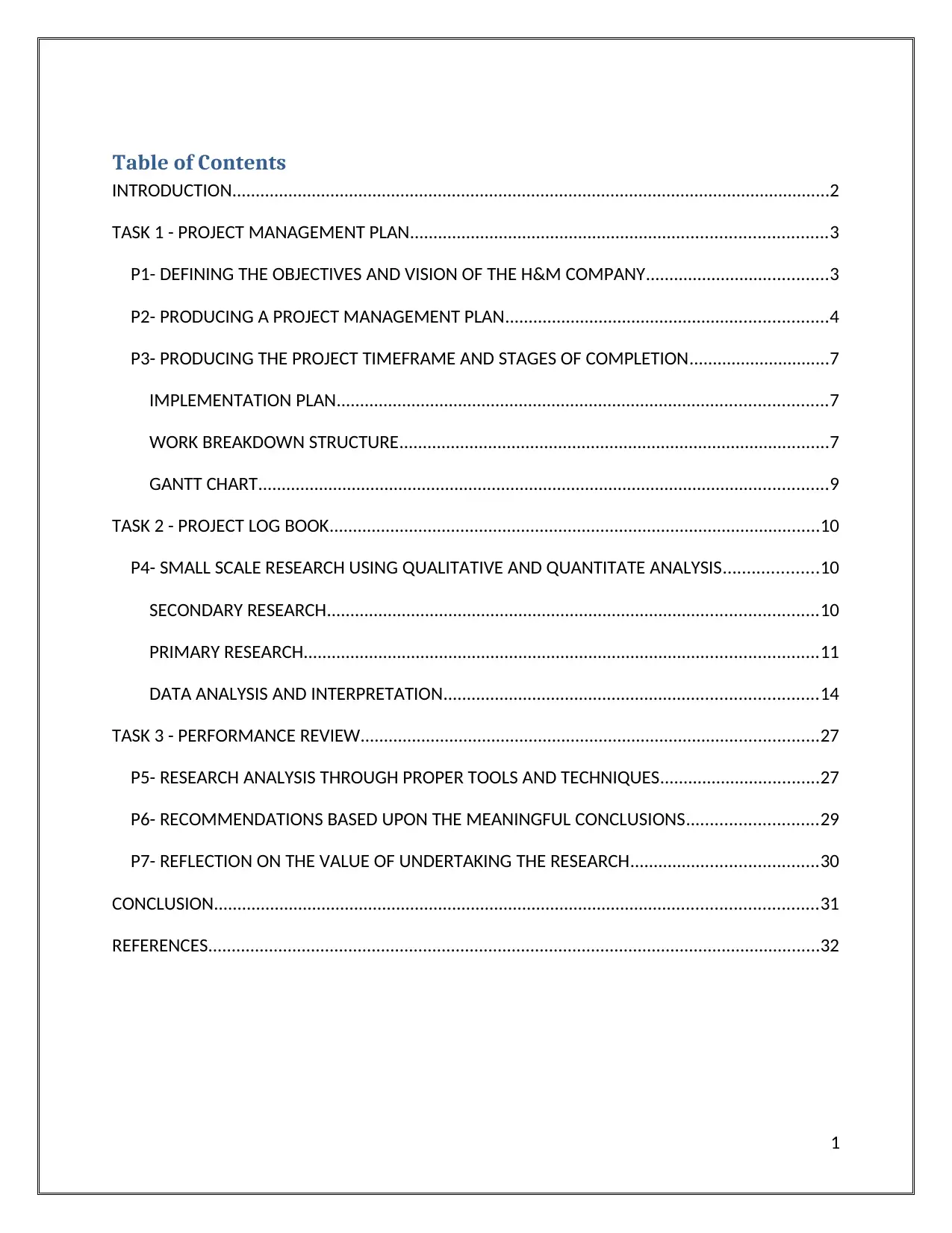
Table of Contents
INTRODUCTION................................................................................................................................2
TASK 1 - PROJECT MANAGEMENT PLAN.........................................................................................3
P1- DEFINING THE OBJECTIVES AND VISION OF THE H&M COMPANY.......................................3
P2- PRODUCING A PROJECT MANAGEMENT PLAN.....................................................................4
P3- PRODUCING THE PROJECT TIMEFRAME AND STAGES OF COMPLETION..............................7
IMPLEMENTATION PLAN.........................................................................................................7
WORK BREAKDOWN STRUCTURE............................................................................................7
GANTT CHART..........................................................................................................................9
TASK 2 - PROJECT LOG BOOK.........................................................................................................10
P4- SMALL SCALE RESEARCH USING QUALITATIVE AND QUANTITATE ANALYSIS....................10
SECONDARY RESEARCH.........................................................................................................10
PRIMARY RESEARCH..............................................................................................................11
DATA ANALYSIS AND INTERPRETATION................................................................................14
TASK 3 - PERFORMANCE REVIEW..................................................................................................27
P5- RESEARCH ANALYSIS THROUGH PROPER TOOLS AND TECHNIQUES..................................27
P6- RECOMMENDATIONS BASED UPON THE MEANINGFUL CONCLUSIONS............................29
P7- REFLECTION ON THE VALUE OF UNDERTAKING THE RESEARCH........................................30
CONCLUSION.................................................................................................................................31
REFERENCES...................................................................................................................................32
1
INTRODUCTION................................................................................................................................2
TASK 1 - PROJECT MANAGEMENT PLAN.........................................................................................3
P1- DEFINING THE OBJECTIVES AND VISION OF THE H&M COMPANY.......................................3
P2- PRODUCING A PROJECT MANAGEMENT PLAN.....................................................................4
P3- PRODUCING THE PROJECT TIMEFRAME AND STAGES OF COMPLETION..............................7
IMPLEMENTATION PLAN.........................................................................................................7
WORK BREAKDOWN STRUCTURE............................................................................................7
GANTT CHART..........................................................................................................................9
TASK 2 - PROJECT LOG BOOK.........................................................................................................10
P4- SMALL SCALE RESEARCH USING QUALITATIVE AND QUANTITATE ANALYSIS....................10
SECONDARY RESEARCH.........................................................................................................10
PRIMARY RESEARCH..............................................................................................................11
DATA ANALYSIS AND INTERPRETATION................................................................................14
TASK 3 - PERFORMANCE REVIEW..................................................................................................27
P5- RESEARCH ANALYSIS THROUGH PROPER TOOLS AND TECHNIQUES..................................27
P6- RECOMMENDATIONS BASED UPON THE MEANINGFUL CONCLUSIONS............................29
P7- REFLECTION ON THE VALUE OF UNDERTAKING THE RESEARCH........................................30
CONCLUSION.................................................................................................................................31
REFERENCES...................................................................................................................................32
1
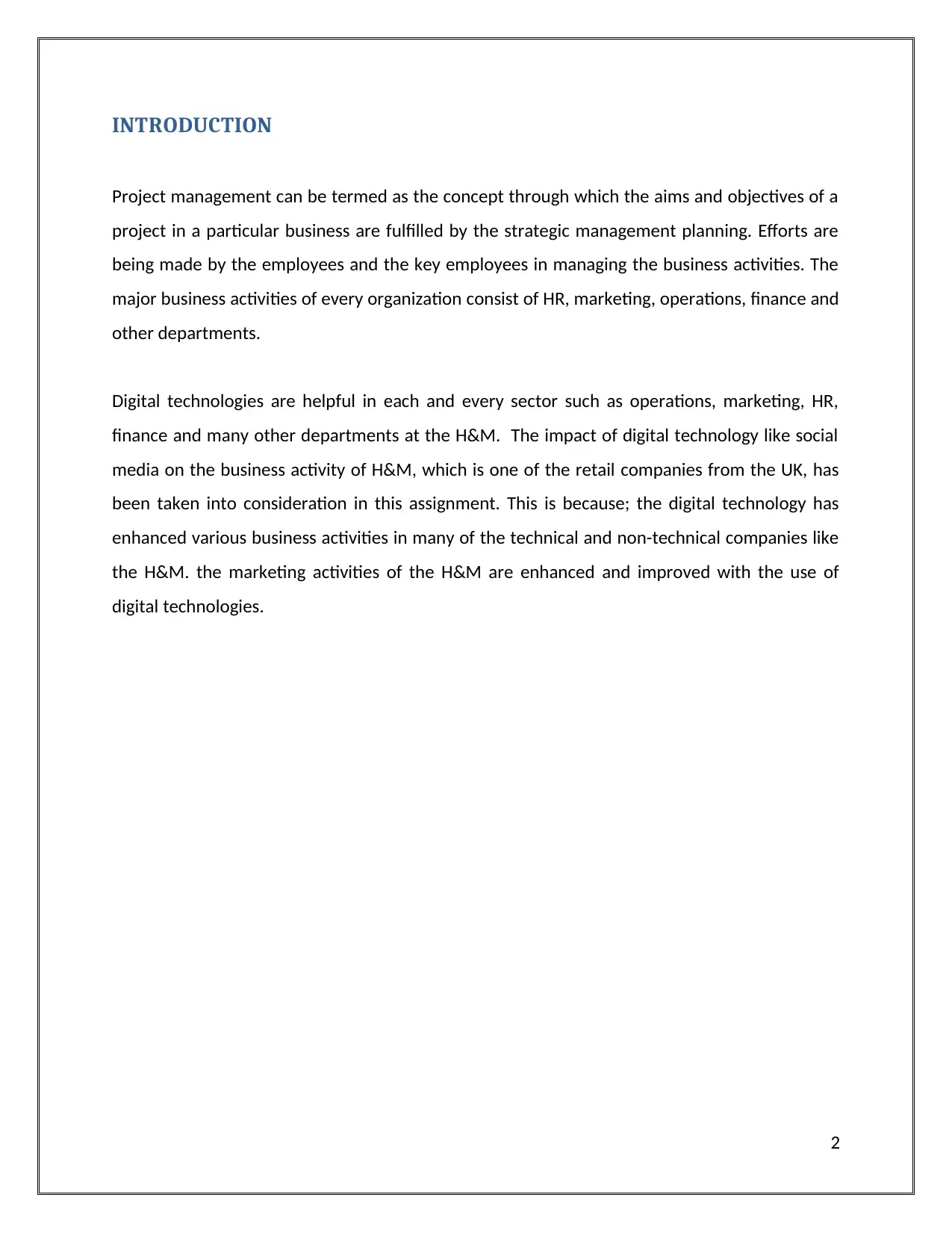
INTRODUCTION
Project management can be termed as the concept through which the aims and objectives of a
project in a particular business are fulfilled by the strategic management planning. Efforts are
being made by the employees and the key employees in managing the business activities. The
major business activities of every organization consist of HR, marketing, operations, finance and
other departments.
Digital technologies are helpful in each and every sector such as operations, marketing, HR,
finance and many other departments at the H&M. The impact of digital technology like social
media on the business activity of H&M, which is one of the retail companies from the UK, has
been taken into consideration in this assignment. This is because; the digital technology has
enhanced various business activities in many of the technical and non-technical companies like
the H&M. the marketing activities of the H&M are enhanced and improved with the use of
digital technologies.
2
Project management can be termed as the concept through which the aims and objectives of a
project in a particular business are fulfilled by the strategic management planning. Efforts are
being made by the employees and the key employees in managing the business activities. The
major business activities of every organization consist of HR, marketing, operations, finance and
other departments.
Digital technologies are helpful in each and every sector such as operations, marketing, HR,
finance and many other departments at the H&M. The impact of digital technology like social
media on the business activity of H&M, which is one of the retail companies from the UK, has
been taken into consideration in this assignment. This is because; the digital technology has
enhanced various business activities in many of the technical and non-technical companies like
the H&M. the marketing activities of the H&M are enhanced and improved with the use of
digital technologies.
2
⊘ This is a preview!⊘
Do you want full access?
Subscribe today to unlock all pages.

Trusted by 1+ million students worldwide
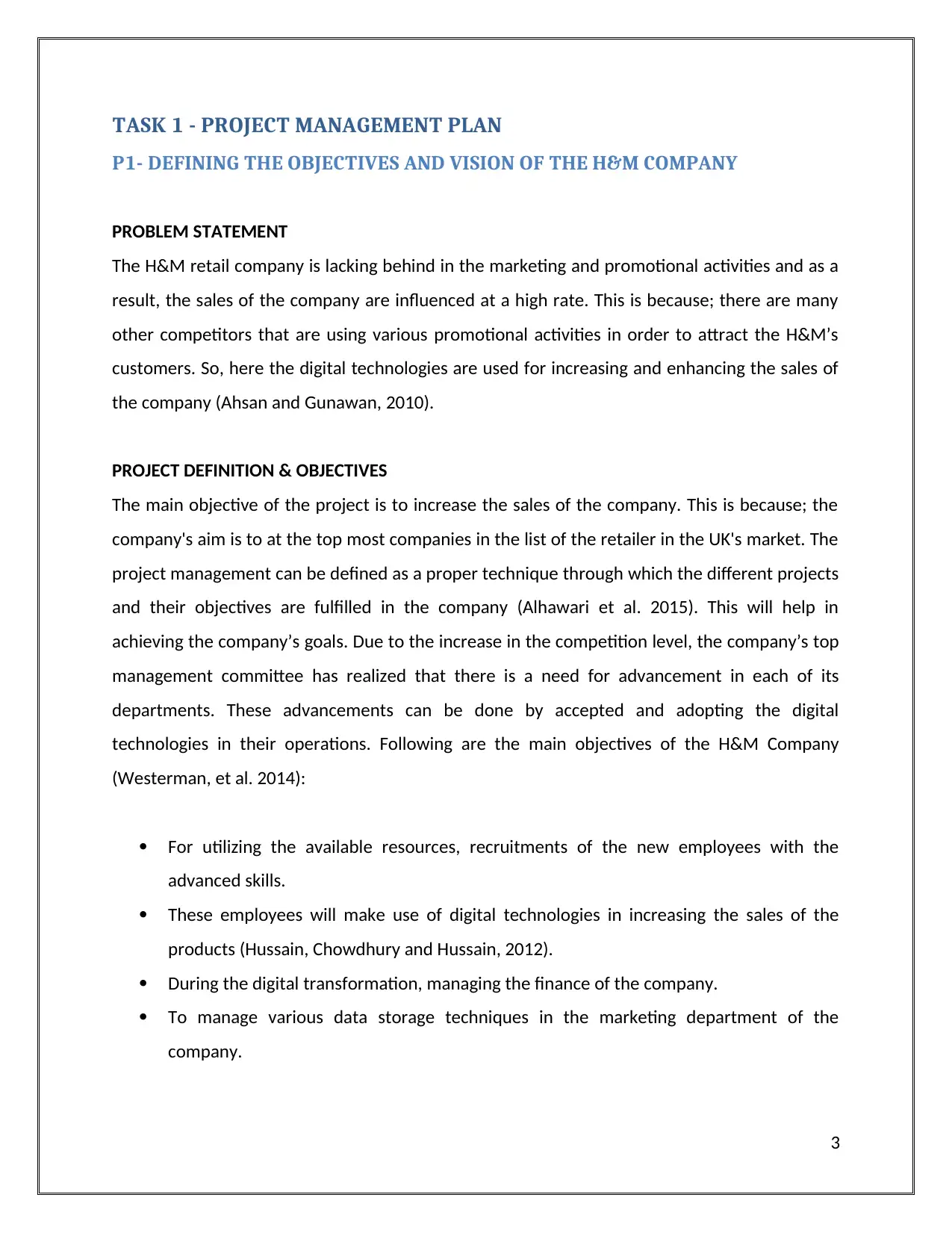
TASK 1 - PROJECT MANAGEMENT PLAN
P1- DEFINING THE OBJECTIVES AND VISION OF THE H&M COMPANY
PROBLEM STATEMENT
The H&M retail company is lacking behind in the marketing and promotional activities and as a
result, the sales of the company are influenced at a high rate. This is because; there are many
other competitors that are using various promotional activities in order to attract the H&M’s
customers. So, here the digital technologies are used for increasing and enhancing the sales of
the company (Ahsan and Gunawan, 2010).
PROJECT DEFINITION & OBJECTIVES
The main objective of the project is to increase the sales of the company. This is because; the
company's aim is to at the top most companies in the list of the retailer in the UK's market. The
project management can be defined as a proper technique through which the different projects
and their objectives are fulfilled in the company (Alhawari et al. 2015). This will help in
achieving the company’s goals. Due to the increase in the competition level, the company’s top
management committee has realized that there is a need for advancement in each of its
departments. These advancements can be done by accepted and adopting the digital
technologies in their operations. Following are the main objectives of the H&M Company
(Westerman, et al. 2014):
For utilizing the available resources, recruitments of the new employees with the
advanced skills.
These employees will make use of digital technologies in increasing the sales of the
products (Hussain, Chowdhury and Hussain, 2012).
During the digital transformation, managing the finance of the company.
To manage various data storage techniques in the marketing department of the
company.
3
P1- DEFINING THE OBJECTIVES AND VISION OF THE H&M COMPANY
PROBLEM STATEMENT
The H&M retail company is lacking behind in the marketing and promotional activities and as a
result, the sales of the company are influenced at a high rate. This is because; there are many
other competitors that are using various promotional activities in order to attract the H&M’s
customers. So, here the digital technologies are used for increasing and enhancing the sales of
the company (Ahsan and Gunawan, 2010).
PROJECT DEFINITION & OBJECTIVES
The main objective of the project is to increase the sales of the company. This is because; the
company's aim is to at the top most companies in the list of the retailer in the UK's market. The
project management can be defined as a proper technique through which the different projects
and their objectives are fulfilled in the company (Alhawari et al. 2015). This will help in
achieving the company’s goals. Due to the increase in the competition level, the company’s top
management committee has realized that there is a need for advancement in each of its
departments. These advancements can be done by accepted and adopting the digital
technologies in their operations. Following are the main objectives of the H&M Company
(Westerman, et al. 2014):
For utilizing the available resources, recruitments of the new employees with the
advanced skills.
These employees will make use of digital technologies in increasing the sales of the
products (Hussain, Chowdhury and Hussain, 2012).
During the digital transformation, managing the finance of the company.
To manage various data storage techniques in the marketing department of the
company.
3
Paraphrase This Document
Need a fresh take? Get an instant paraphrase of this document with our AI Paraphraser
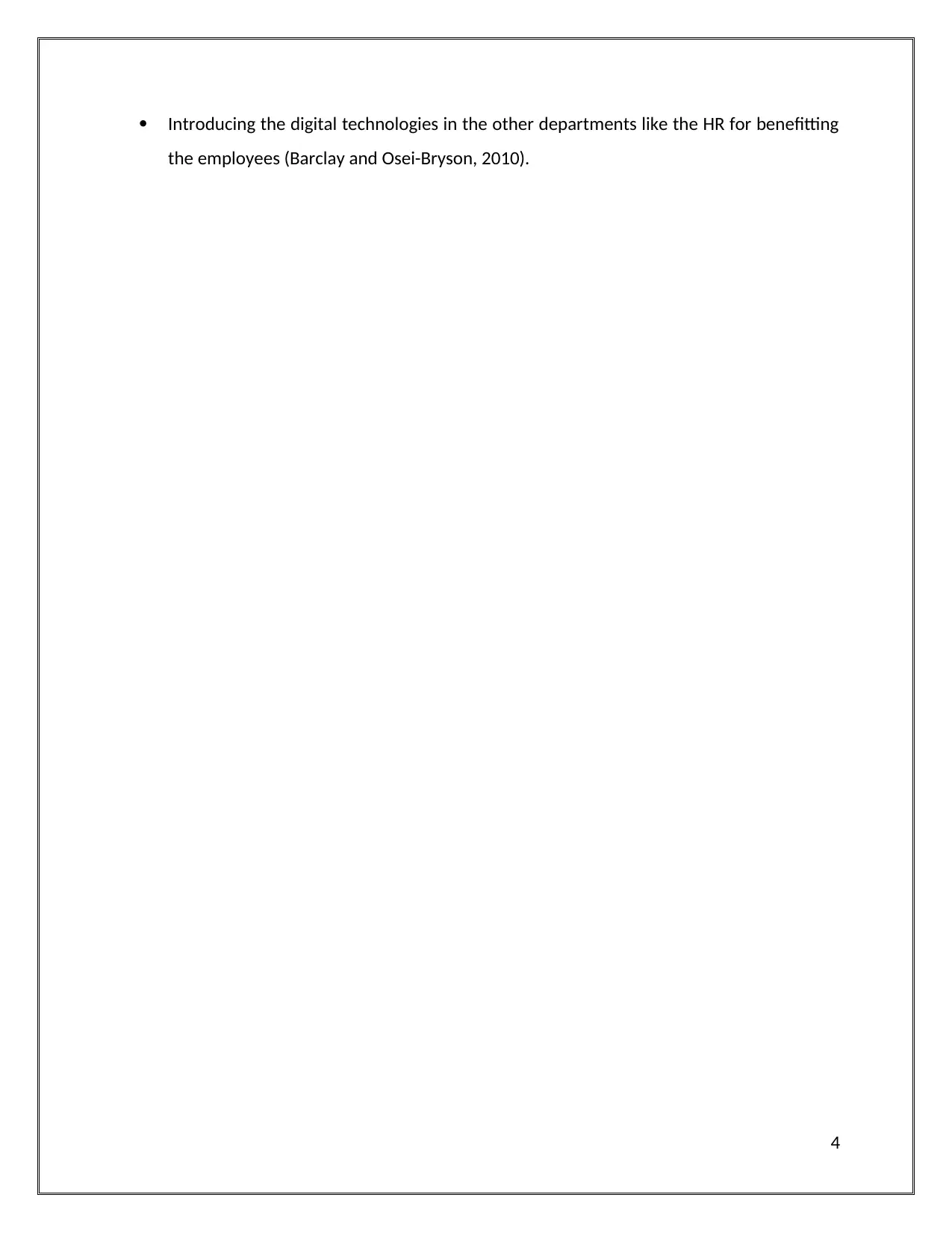
Introducing the digital technologies in the other departments like the HR for benefitting
the employees (Barclay and Osei-Bryson, 2010).
4
the employees (Barclay and Osei-Bryson, 2010).
4
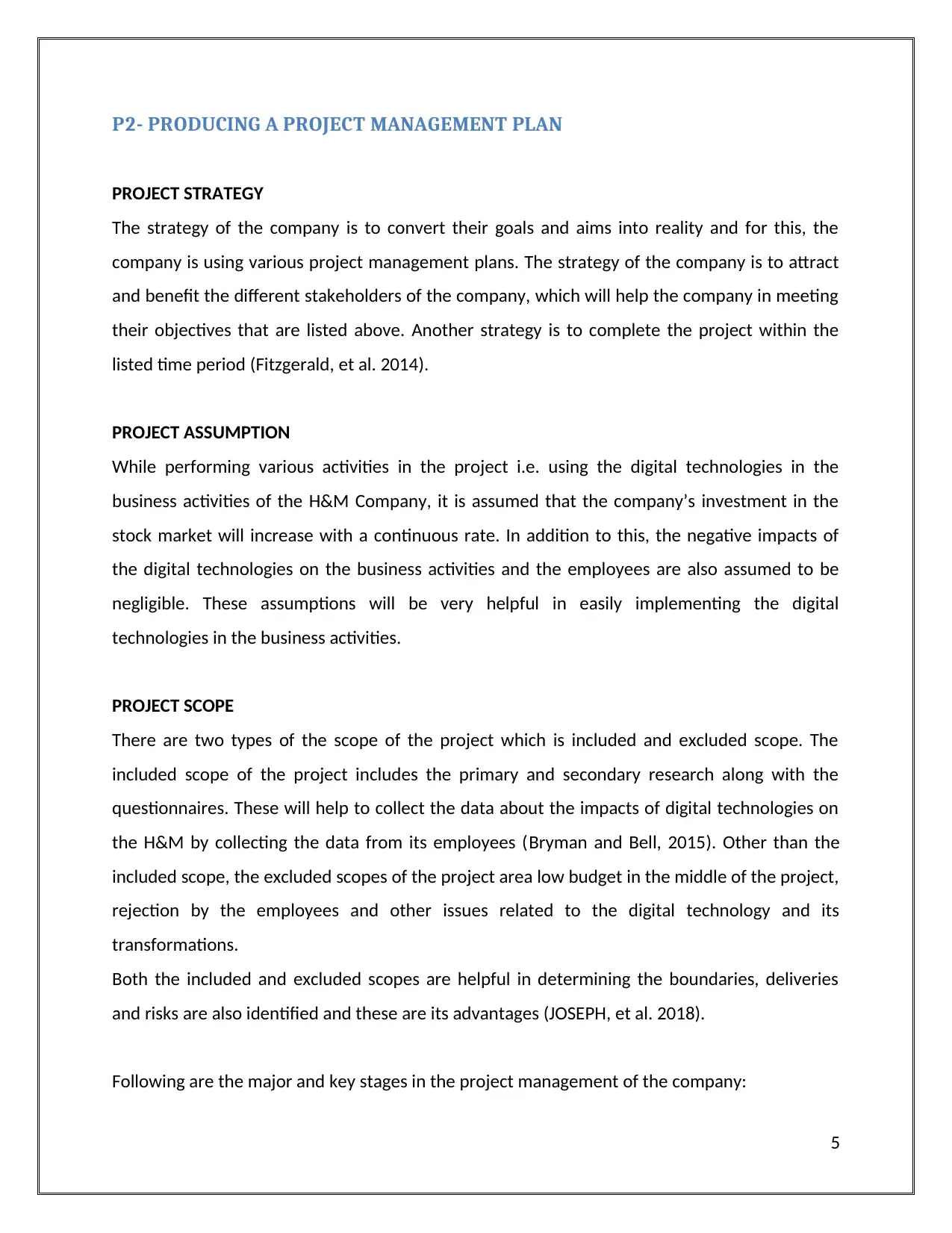
P2- PRODUCING A PROJECT MANAGEMENT PLAN
PROJECT STRATEGY
The strategy of the company is to convert their goals and aims into reality and for this, the
company is using various project management plans. The strategy of the company is to attract
and benefit the different stakeholders of the company, which will help the company in meeting
their objectives that are listed above. Another strategy is to complete the project within the
listed time period (Fitzgerald, et al. 2014).
PROJECT ASSUMPTION
While performing various activities in the project i.e. using the digital technologies in the
business activities of the H&M Company, it is assumed that the company’s investment in the
stock market will increase with a continuous rate. In addition to this, the negative impacts of
the digital technologies on the business activities and the employees are also assumed to be
negligible. These assumptions will be very helpful in easily implementing the digital
technologies in the business activities.
PROJECT SCOPE
There are two types of the scope of the project which is included and excluded scope. The
included scope of the project includes the primary and secondary research along with the
questionnaires. These will help to collect the data about the impacts of digital technologies on
the H&M by collecting the data from its employees (Bryman and Bell, 2015). Other than the
included scope, the excluded scopes of the project area low budget in the middle of the project,
rejection by the employees and other issues related to the digital technology and its
transformations.
Both the included and excluded scopes are helpful in determining the boundaries, deliveries
and risks are also identified and these are its advantages (JOSEPH, et al. 2018).
Following are the major and key stages in the project management of the company:
5
PROJECT STRATEGY
The strategy of the company is to convert their goals and aims into reality and for this, the
company is using various project management plans. The strategy of the company is to attract
and benefit the different stakeholders of the company, which will help the company in meeting
their objectives that are listed above. Another strategy is to complete the project within the
listed time period (Fitzgerald, et al. 2014).
PROJECT ASSUMPTION
While performing various activities in the project i.e. using the digital technologies in the
business activities of the H&M Company, it is assumed that the company’s investment in the
stock market will increase with a continuous rate. In addition to this, the negative impacts of
the digital technologies on the business activities and the employees are also assumed to be
negligible. These assumptions will be very helpful in easily implementing the digital
technologies in the business activities.
PROJECT SCOPE
There are two types of the scope of the project which is included and excluded scope. The
included scope of the project includes the primary and secondary research along with the
questionnaires. These will help to collect the data about the impacts of digital technologies on
the H&M by collecting the data from its employees (Bryman and Bell, 2015). Other than the
included scope, the excluded scopes of the project area low budget in the middle of the project,
rejection by the employees and other issues related to the digital technology and its
transformations.
Both the included and excluded scopes are helpful in determining the boundaries, deliveries
and risks are also identified and these are its advantages (JOSEPH, et al. 2018).
Following are the major and key stages in the project management of the company:
5
⊘ This is a preview!⊘
Do you want full access?
Subscribe today to unlock all pages.

Trusted by 1+ million students worldwide
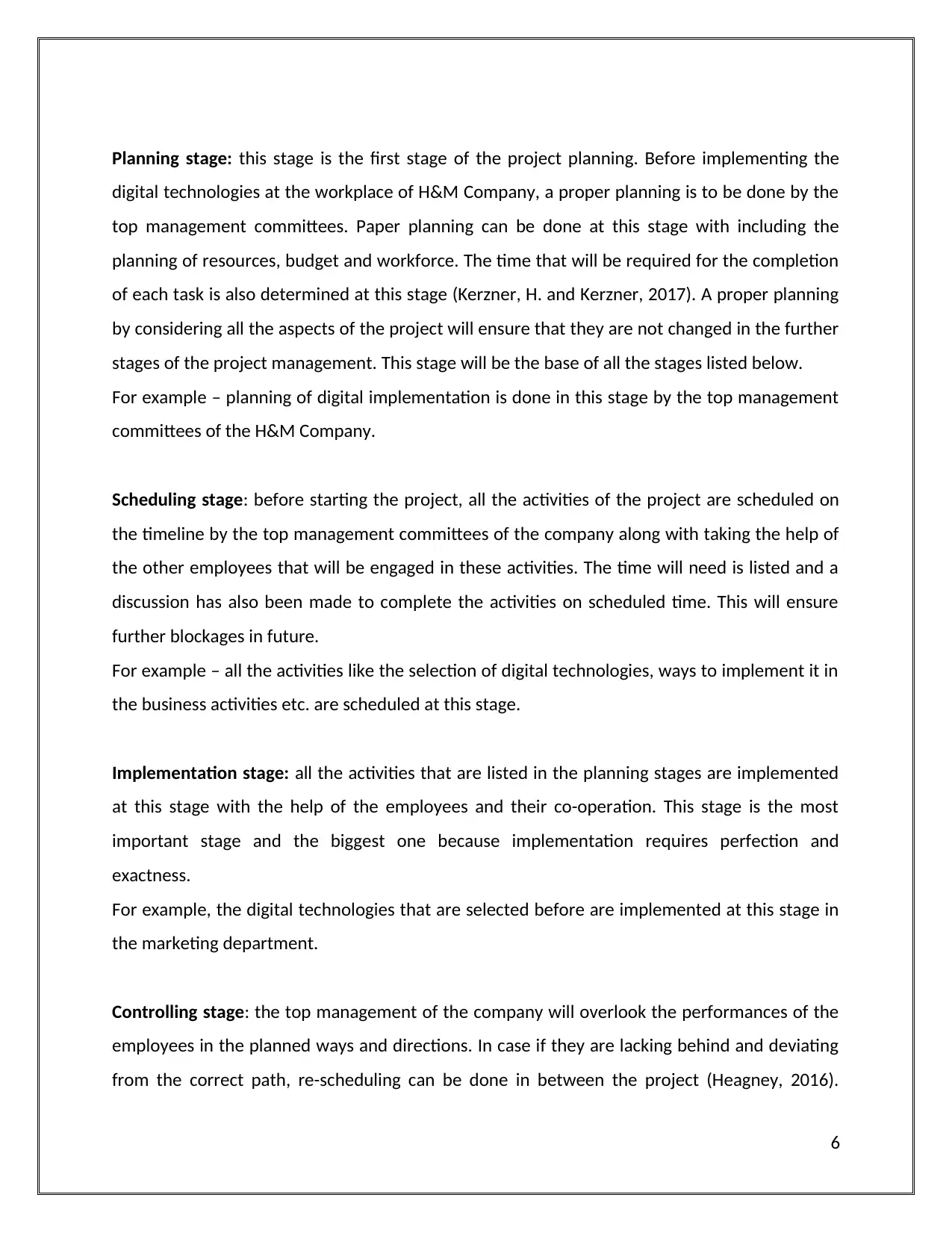
Planning stage: this stage is the first stage of the project planning. Before implementing the
digital technologies at the workplace of H&M Company, a proper planning is to be done by the
top management committees. Paper planning can be done at this stage with including the
planning of resources, budget and workforce. The time that will be required for the completion
of each task is also determined at this stage (Kerzner, H. and Kerzner, 2017). A proper planning
by considering all the aspects of the project will ensure that they are not changed in the further
stages of the project management. This stage will be the base of all the stages listed below.
For example – planning of digital implementation is done in this stage by the top management
committees of the H&M Company.
Scheduling stage: before starting the project, all the activities of the project are scheduled on
the timeline by the top management committees of the company along with taking the help of
the other employees that will be engaged in these activities. The time will need is listed and a
discussion has also been made to complete the activities on scheduled time. This will ensure
further blockages in future.
For example – all the activities like the selection of digital technologies, ways to implement it in
the business activities etc. are scheduled at this stage.
Implementation stage: all the activities that are listed in the planning stages are implemented
at this stage with the help of the employees and their co-operation. This stage is the most
important stage and the biggest one because implementation requires perfection and
exactness.
For example, the digital technologies that are selected before are implemented at this stage in
the marketing department.
Controlling stage: the top management of the company will overlook the performances of the
employees in the planned ways and directions. In case if they are lacking behind and deviating
from the correct path, re-scheduling can be done in between the project (Heagney, 2016).
6
digital technologies at the workplace of H&M Company, a proper planning is to be done by the
top management committees. Paper planning can be done at this stage with including the
planning of resources, budget and workforce. The time that will be required for the completion
of each task is also determined at this stage (Kerzner, H. and Kerzner, 2017). A proper planning
by considering all the aspects of the project will ensure that they are not changed in the further
stages of the project management. This stage will be the base of all the stages listed below.
For example – planning of digital implementation is done in this stage by the top management
committees of the H&M Company.
Scheduling stage: before starting the project, all the activities of the project are scheduled on
the timeline by the top management committees of the company along with taking the help of
the other employees that will be engaged in these activities. The time will need is listed and a
discussion has also been made to complete the activities on scheduled time. This will ensure
further blockages in future.
For example – all the activities like the selection of digital technologies, ways to implement it in
the business activities etc. are scheduled at this stage.
Implementation stage: all the activities that are listed in the planning stages are implemented
at this stage with the help of the employees and their co-operation. This stage is the most
important stage and the biggest one because implementation requires perfection and
exactness.
For example, the digital technologies that are selected before are implemented at this stage in
the marketing department.
Controlling stage: the top management of the company will overlook the performances of the
employees in the planned ways and directions. In case if they are lacking behind and deviating
from the correct path, re-scheduling can be done in between the project (Heagney, 2016).
6
Paraphrase This Document
Need a fresh take? Get an instant paraphrase of this document with our AI Paraphraser
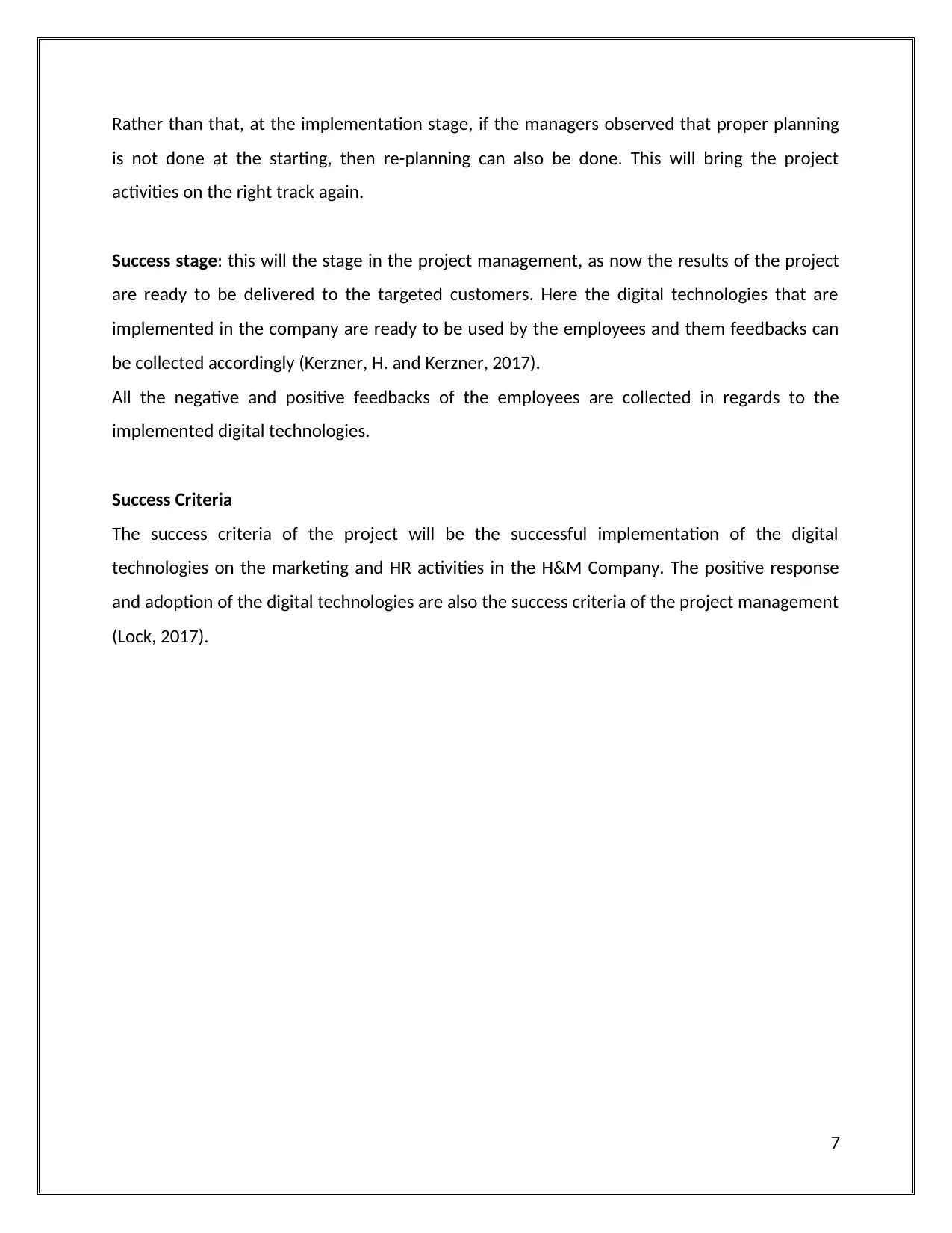
Rather than that, at the implementation stage, if the managers observed that proper planning
is not done at the starting, then re-planning can also be done. This will bring the project
activities on the right track again.
Success stage: this will the stage in the project management, as now the results of the project
are ready to be delivered to the targeted customers. Here the digital technologies that are
implemented in the company are ready to be used by the employees and them feedbacks can
be collected accordingly (Kerzner, H. and Kerzner, 2017).
All the negative and positive feedbacks of the employees are collected in regards to the
implemented digital technologies.
Success Criteria
The success criteria of the project will be the successful implementation of the digital
technologies on the marketing and HR activities in the H&M Company. The positive response
and adoption of the digital technologies are also the success criteria of the project management
(Lock, 2017).
7
is not done at the starting, then re-planning can also be done. This will bring the project
activities on the right track again.
Success stage: this will the stage in the project management, as now the results of the project
are ready to be delivered to the targeted customers. Here the digital technologies that are
implemented in the company are ready to be used by the employees and them feedbacks can
be collected accordingly (Kerzner, H. and Kerzner, 2017).
All the negative and positive feedbacks of the employees are collected in regards to the
implemented digital technologies.
Success Criteria
The success criteria of the project will be the successful implementation of the digital
technologies on the marketing and HR activities in the H&M Company. The positive response
and adoption of the digital technologies are also the success criteria of the project management
(Lock, 2017).
7
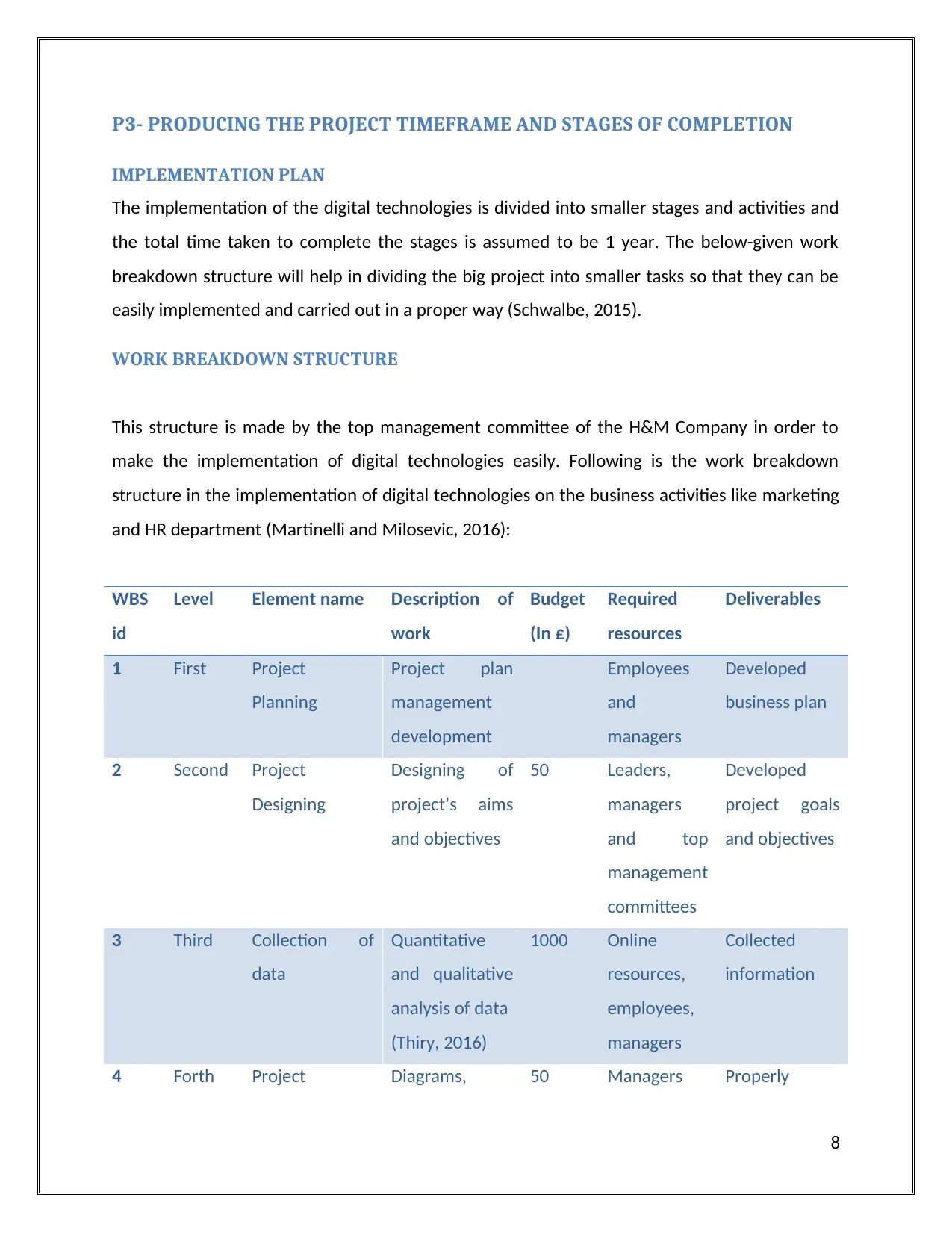
P3- PRODUCING THE PROJECT TIMEFRAME AND STAGES OF COMPLETION
IMPLEMENTATION PLAN
The implementation of the digital technologies is divided into smaller stages and activities and
the total time taken to complete the stages is assumed to be 1 year. The below-given work
breakdown structure will help in dividing the big project into smaller tasks so that they can be
easily implemented and carried out in a proper way (Schwalbe, 2015).
WORK BREAKDOWN STRUCTURE
This structure is made by the top management committee of the H&M Company in order to
make the implementation of digital technologies easily. Following is the work breakdown
structure in the implementation of digital technologies on the business activities like marketing
and HR department (Martinelli and Milosevic, 2016):
WBS
id
Level Element name Description of
work
Budget
(In £)
Required
resources
Deliverables
1 First Project
Planning
Project plan
management
development
Employees
and
managers
Developed
business plan
2 Second Project
Designing
Designing of
project’s aims
and objectives
50 Leaders,
managers
and top
management
committees
Developed
project goals
and objectives
3 Third Collection of
data
Quantitative
and qualitative
analysis of data
(Thiry, 2016)
1000 Online
resources,
employees,
managers
Collected
information
4 Forth Project Diagrams, 50 Managers Properly
8
IMPLEMENTATION PLAN
The implementation of the digital technologies is divided into smaller stages and activities and
the total time taken to complete the stages is assumed to be 1 year. The below-given work
breakdown structure will help in dividing the big project into smaller tasks so that they can be
easily implemented and carried out in a proper way (Schwalbe, 2015).
WORK BREAKDOWN STRUCTURE
This structure is made by the top management committee of the H&M Company in order to
make the implementation of digital technologies easily. Following is the work breakdown
structure in the implementation of digital technologies on the business activities like marketing
and HR department (Martinelli and Milosevic, 2016):
WBS
id
Level Element name Description of
work
Budget
(In £)
Required
resources
Deliverables
1 First Project
Planning
Project plan
management
development
Employees
and
managers
Developed
business plan
2 Second Project
Designing
Designing of
project’s aims
and objectives
50 Leaders,
managers
and top
management
committees
Developed
project goals
and objectives
3 Third Collection of
data
Quantitative
and qualitative
analysis of data
(Thiry, 2016)
1000 Online
resources,
employees,
managers
Collected
information
4 Forth Project Diagrams, 50 Managers Properly
8
⊘ This is a preview!⊘
Do you want full access?
Subscribe today to unlock all pages.

Trusted by 1+ million students worldwide
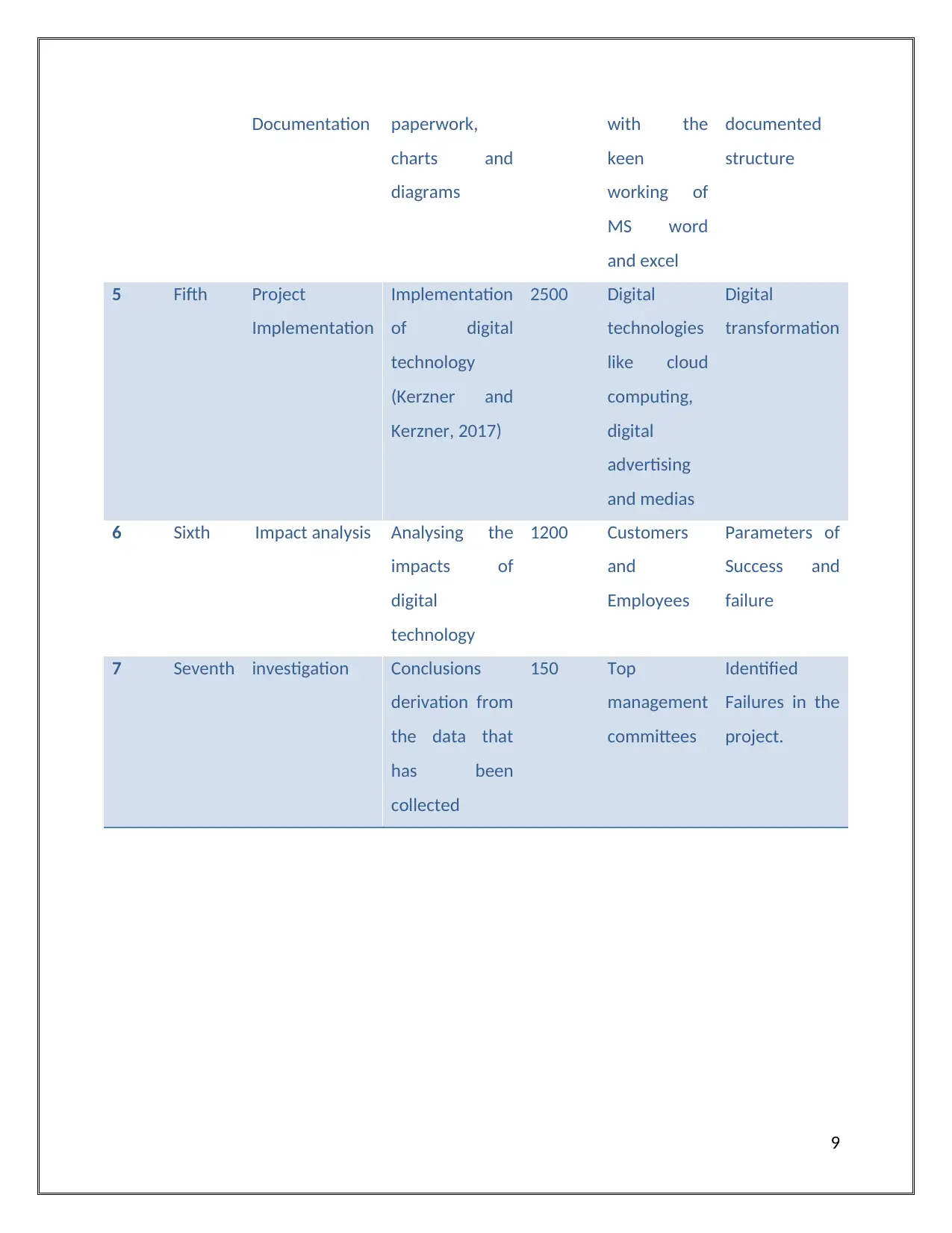
Documentation paperwork,
charts and
diagrams
with the
keen
working of
MS word
and excel
documented
structure
5 Fifth Project
Implementation
Implementation
of digital
technology
(Kerzner and
Kerzner, 2017)
2500 Digital
technologies
like cloud
computing,
digital
advertising
and medias
Digital
transformation
6 Sixth Impact analysis Analysing the
impacts of
digital
technology
1200 Customers
and
Employees
Parameters of
Success and
failure
7 Seventh investigation Conclusions
derivation from
the data that
has been
collected
150 Top
management
committees
Identified
Failures in the
project.
9
charts and
diagrams
with the
keen
working of
MS word
and excel
documented
structure
5 Fifth Project
Implementation
Implementation
of digital
technology
(Kerzner and
Kerzner, 2017)
2500 Digital
technologies
like cloud
computing,
digital
advertising
and medias
Digital
transformation
6 Sixth Impact analysis Analysing the
impacts of
digital
technology
1200 Customers
and
Employees
Parameters of
Success and
failure
7 Seventh investigation Conclusions
derivation from
the data that
has been
collected
150 Top
management
committees
Identified
Failures in the
project.
9
Paraphrase This Document
Need a fresh take? Get an instant paraphrase of this document with our AI Paraphraser
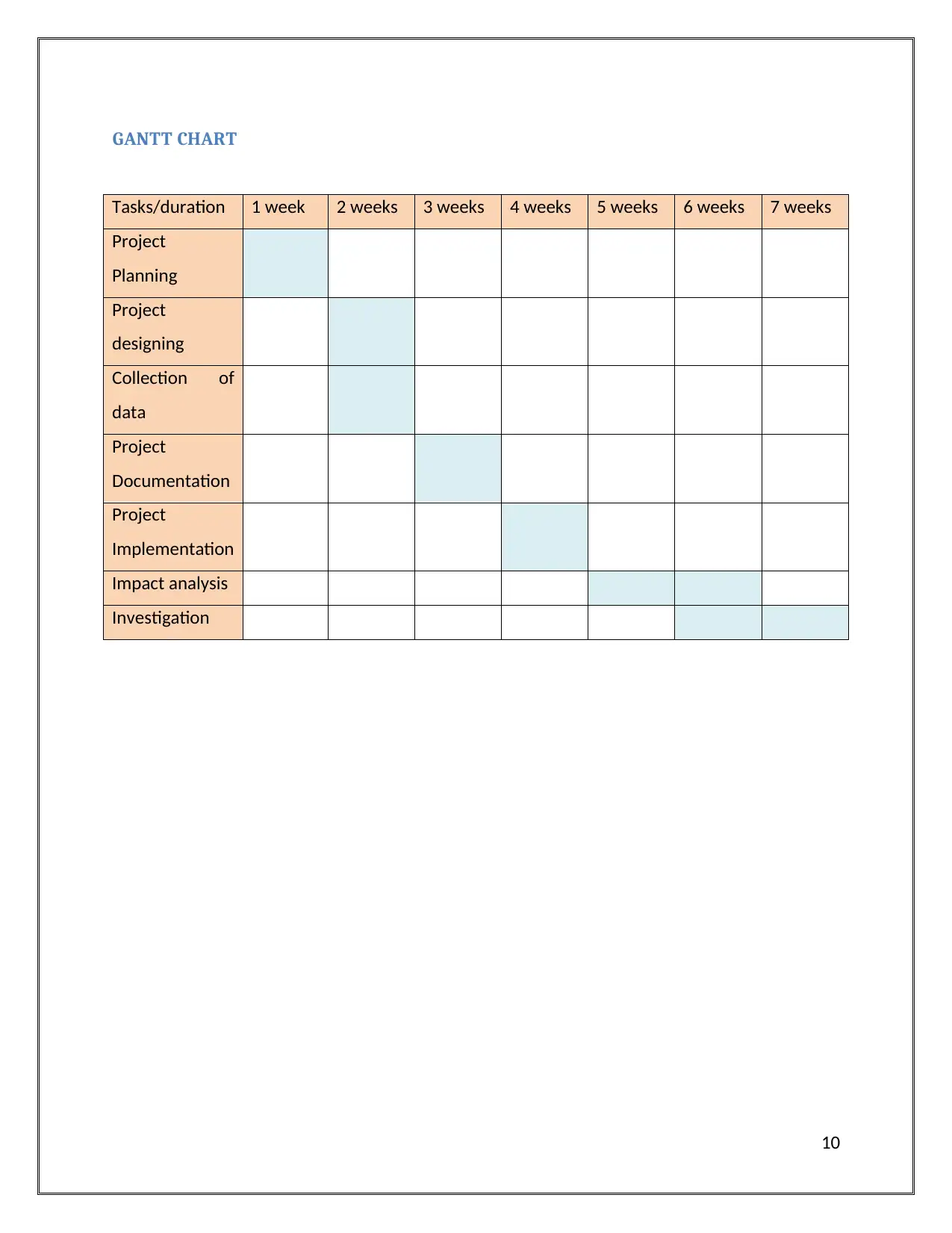
GANTT CHART
Tasks/duration 1 week 2 weeks 3 weeks 4 weeks 5 weeks 6 weeks 7 weeks
Project
Planning
Project
designing
Collection of
data
Project
Documentation
Project
Implementation
Impact analysis
Investigation
10
Tasks/duration 1 week 2 weeks 3 weeks 4 weeks 5 weeks 6 weeks 7 weeks
Project
Planning
Project
designing
Collection of
data
Project
Documentation
Project
Implementation
Impact analysis
Investigation
10
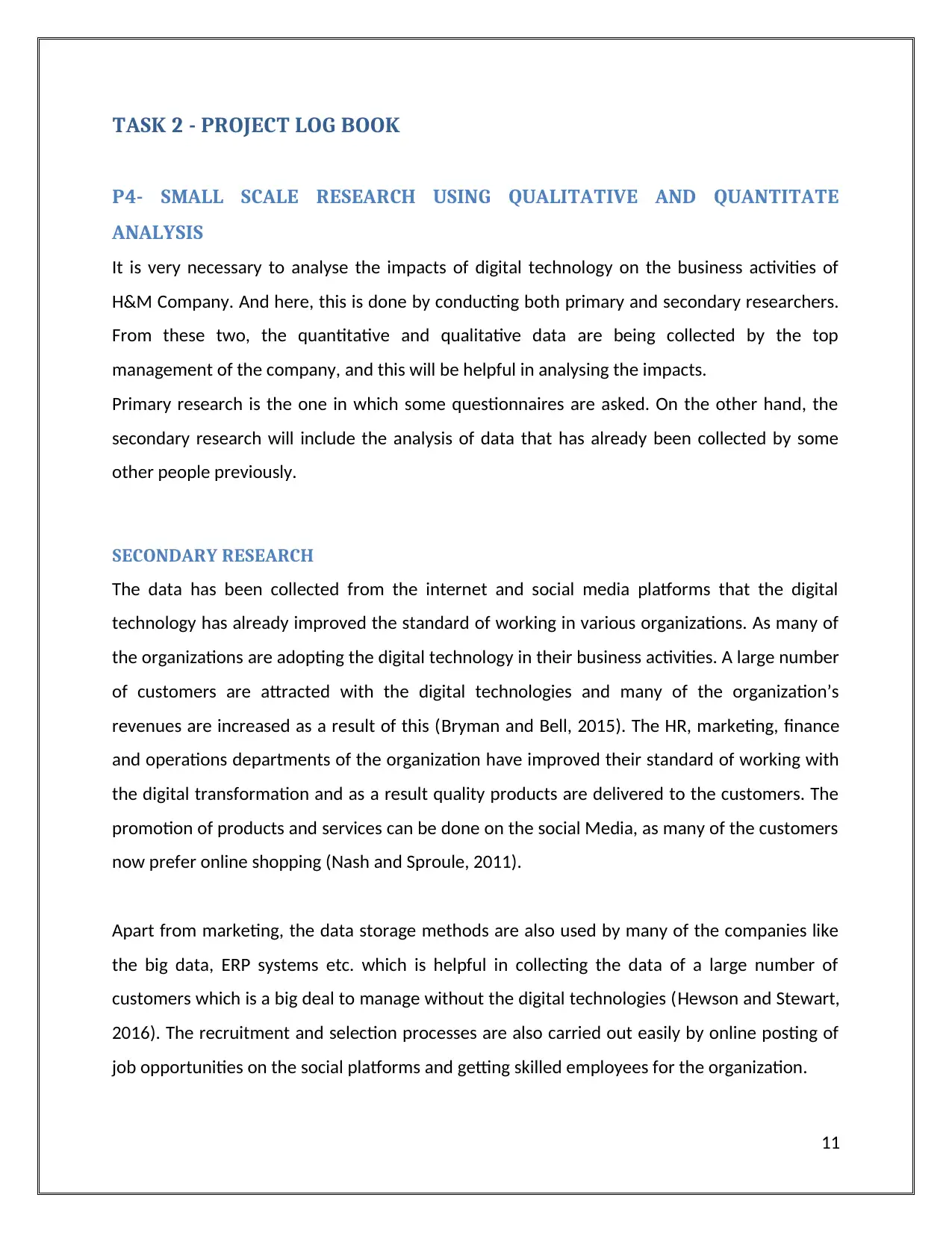
TASK 2 - PROJECT LOG BOOK
P4- SMALL SCALE RESEARCH USING QUALITATIVE AND QUANTITATE
ANALYSIS
It is very necessary to analyse the impacts of digital technology on the business activities of
H&M Company. And here, this is done by conducting both primary and secondary researchers.
From these two, the quantitative and qualitative data are being collected by the top
management of the company, and this will be helpful in analysing the impacts.
Primary research is the one in which some questionnaires are asked. On the other hand, the
secondary research will include the analysis of data that has already been collected by some
other people previously.
SECONDARY RESEARCH
The data has been collected from the internet and social media platforms that the digital
technology has already improved the standard of working in various organizations. As many of
the organizations are adopting the digital technology in their business activities. A large number
of customers are attracted with the digital technologies and many of the organization’s
revenues are increased as a result of this (Bryman and Bell, 2015). The HR, marketing, finance
and operations departments of the organization have improved their standard of working with
the digital transformation and as a result quality products are delivered to the customers. The
promotion of products and services can be done on the social Media, as many of the customers
now prefer online shopping (Nash and Sproule, 2011).
Apart from marketing, the data storage methods are also used by many of the companies like
the big data, ERP systems etc. which is helpful in collecting the data of a large number of
customers which is a big deal to manage without the digital technologies (Hewson and Stewart,
2016). The recruitment and selection processes are also carried out easily by online posting of
job opportunities on the social platforms and getting skilled employees for the organization.
11
P4- SMALL SCALE RESEARCH USING QUALITATIVE AND QUANTITATE
ANALYSIS
It is very necessary to analyse the impacts of digital technology on the business activities of
H&M Company. And here, this is done by conducting both primary and secondary researchers.
From these two, the quantitative and qualitative data are being collected by the top
management of the company, and this will be helpful in analysing the impacts.
Primary research is the one in which some questionnaires are asked. On the other hand, the
secondary research will include the analysis of data that has already been collected by some
other people previously.
SECONDARY RESEARCH
The data has been collected from the internet and social media platforms that the digital
technology has already improved the standard of working in various organizations. As many of
the organizations are adopting the digital technology in their business activities. A large number
of customers are attracted with the digital technologies and many of the organization’s
revenues are increased as a result of this (Bryman and Bell, 2015). The HR, marketing, finance
and operations departments of the organization have improved their standard of working with
the digital transformation and as a result quality products are delivered to the customers. The
promotion of products and services can be done on the social Media, as many of the customers
now prefer online shopping (Nash and Sproule, 2011).
Apart from marketing, the data storage methods are also used by many of the companies like
the big data, ERP systems etc. which is helpful in collecting the data of a large number of
customers which is a big deal to manage without the digital technologies (Hewson and Stewart,
2016). The recruitment and selection processes are also carried out easily by online posting of
job opportunities on the social platforms and getting skilled employees for the organization.
11
⊘ This is a preview!⊘
Do you want full access?
Subscribe today to unlock all pages.

Trusted by 1+ million students worldwide
1 out of 38
Related Documents
Your All-in-One AI-Powered Toolkit for Academic Success.
+13062052269
info@desklib.com
Available 24*7 on WhatsApp / Email
![[object Object]](/_next/static/media/star-bottom.7253800d.svg)
Unlock your academic potential
Copyright © 2020–2025 A2Z Services. All Rights Reserved. Developed and managed by ZUCOL.





